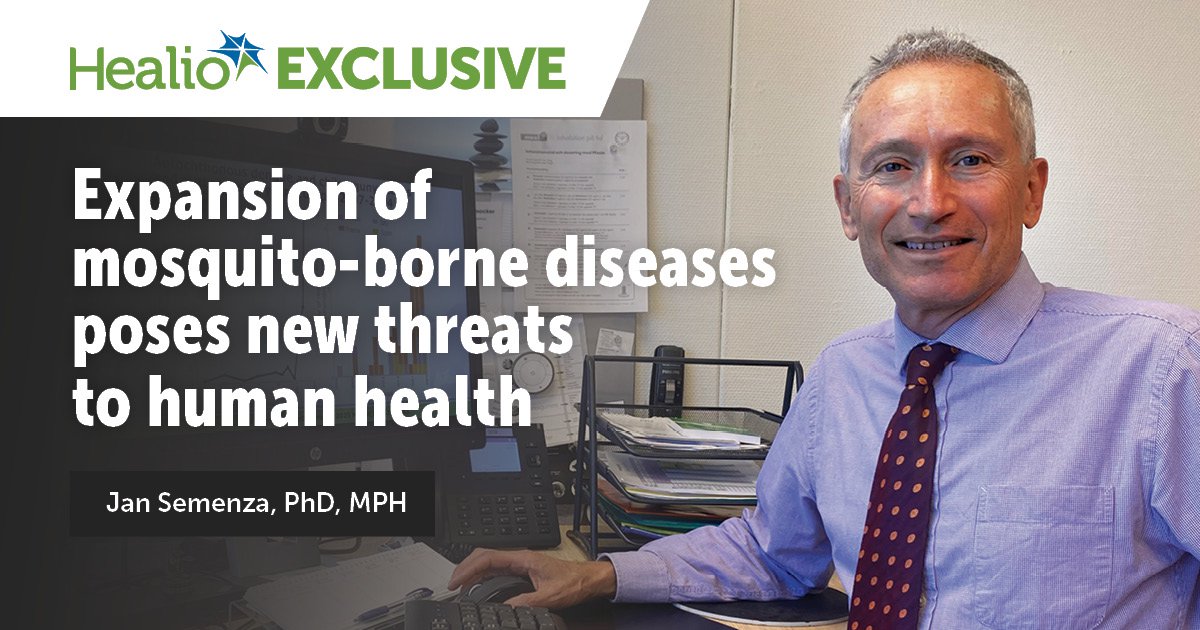August 13, 2025
14 min read
Key takeaways:
- Serious interventions are needed to contain the spread of mosquito-borne diseases.
- Global warming, poverty and heavily interconnected populations contribute to expansion of these conditions.
Driven by climate change, population mobility and global trade, mosquito-borne diseases are extending beyond tropical and subtropical areas.
Outbreaks of dengue, chikungunya and Zika, carried by Aedes mosquitoes, are increasingly occurring in Europe and North America. Aedes mosquitoes, including Aedes aegypti and Aedes albopictus (Asian tiger mosquitoes), are known vectors of several diseases. Yearly recurring outbreaks of West Nile virus, transmitted from birds to humans by Culex mosquitoes, have been reported in recent years. And dirofilariasis, already common in pet dogs in Europe and North America, can affect humans through the bite of infective mosquitoes.

Image: Cristina C. Duran, MD, MS, Hammarby Sjöstads Husläkare
All these diseases have a wide spectrum of clinical manifestations, including ocular issues, with varying levels of severity. The quicker the response to these outbreaks, the better the chance to contain them, and it is therefore important to spread awareness of this emerging threat.
“It is mandatory that the public and health care professionals are alerted because we cannot be sound asleep at the switch,” Jan C. Semenza, PhD, MPH, said.
Semenza is an environmental epidemiologist with 30 years of experience in climate change and health, professor at Umeå University in Sweden, and former head of the Health Determinants Programme at the European Centre for Disease Prevention and Control (ECDC).
Rubens Belfort Jr., MD, PhD, professor and president of the Vision Institute, Federal University of São Paulo in Brazil, compared the outbreaks of mosquito-borne diseases to tsunamis.
“Most of the time, we cannot predict them or avoid them, but we can minimize damage,” he said. “We need sentinel units able to detect the initial cases and trigger health procedures, but we don’t have these systems in place in most countries. Therefore, mosquitoes will continue to be a big problem.”
Using a multi-disease ecological niche model, Lim and colleagues created global environmental suitability maps for mosquito-borne diseases, estimating that 5.66 billion people live in areas currently suitable for dengue, chikungunya and Zika. Of these, 170 million live in Europe and 730 million in the Americas.
An invasive species
Asian tiger mosquitoes were likely introduced in the United States and Europe through used tires, shipped from Asia to Texas in 1985 and from Georgia to Italy 5 years later.
“Water accumulates in used tires, and then mosquitoes lay their eggs in these puddles,” Semenza said. “The water evaporates, but the eggs don’t die, and when it rains, they get rehydrated and hatch. This mosquito is a very invasive species and a very aggressive biter.”
The first outbreaks of locally transmitted Zika and chikungunya reported in the Americas occurred in 2013 and 2015, respectively, and chikungunya outbreaks occurred in Italy in 2007 and 2017. Since 2010, outbreaks of dengue have emerged in Croatia, Italy, Spain and the south of France.
“It took 20 years or more until we had the first outbreak, but the problem is that the time span between the establishment of the mosquito in a district and an outbreak has now collapsed down to 5 years,” Semenza said. “In fact, if you look at warm regions in Europe, this transition to an endemic situation happens much faster as compared to colder regions. First you have the importation of the virus in a viremic passenger who gets bitten by a local Asian tiger mosquito. Conducive climatic conditions lead to local outbreaks when an infected mosquito bites someone else. So, we are very concerned about both population movement and climate change, which are the two factors leading to the exponential increase in the number of cases we are seeing in Europe. If you look at the data, it’s an exponential increase.”
Because Asian tiger mosquitoes are rapidly spreading northward in Europe from the south, the whole continent may now face a transition from sporadic, occasional outbreaks to an endemic situation of recurrent, big outbreaks on a regular basis.
“This will have a huge impact on health care systems but also on our economies, particularly on the tourist industry,” Semenza said.
More investment in vaccines needed
“We have been fighting mosquitoes for generations, and so far, we’ve been losing most of the battles,” Belfort said. “Yellow fever is a good example. Malaria is another terrible situation, but there’s more than that. No doubt, the warming of the planet has made the situation much worse. In the past, we used to talk a lot about tropical diseases. Nowadays, the truth is that tropical diseases are part of the reality in most countries.”

Global warming, poverty, heavily interconnected populations and the possibility to travel the globe in a few hours help quickly disseminate mosquito-borne diseases.
In addition, many countries are experiencing a significant increase in the number of older people and people living with chronic diseases that make them more susceptible to complications.
“Health systems are not prepared, and there is a tendency to decrease the amount of money and efforts to deal with infectious disease epidemiology and vaccines,” Belfort said. “In the U.S., we have already seen many of these grants being canceled and many people being discouraged to work in public health.”
Currently, there are no approved vaccines to protect against Zika virus and West Nile virus in humans. There is only one vaccine available for dengue in the United States, with a still uncertain efficacy and safety profile, and it is unable to protect against all subtypes of the disease.
“There is a yellow fever vaccine, but the technology is from the 1940s. It is old, it has many side effects, and we take it here because there is nothing else better,” Belfort said. “For malaria, after hundreds of years, it seems that finally we have some vaccine that would help, but again, it lacks further demonstration and a program that will increase access to it.”
As for chikungunya, progress has been made with a recently approved virus-like particle vaccine with reportedly fewer side effects than the previous live-attenuated vaccine.
“We need more research regarding prevention and vaccines not only in the U.S. but also in Europe, where many countries are not investing as much as it is needed,” Belfort said.
He expressed concern about widening anti-vaccination attitudes and misleading claims that might affect vaccination policies and threaten immunization programs.
“It is true that vaccines sometimes are not as good as they should be, but this is information that should bring us ahead and not bring us back,” he said.
Ocular manifestations
Mosquito-borne diseases are the cause of a wide array of ocular complications, from conjunctivitis and keratitis to posterior and diffuse uveitis, vitritis, retinal vasculitis, vascular occlusion, hemorrhages, retinochoroiditis, serous retinal detachment and more.
These manifestations can appear in a variety of other diseases, and an accurate differential diagnosis is critical.
“It starts with a good conversation and knowing the epidemiology and risk factors that are connected with where patients live, their activities and their movements,” Belfort said. “Often, we have people who go, for instance, to the Amazon or Africa and come back with unusual diseases.”
Knowledge of non-ocular signs and symptoms is also important, as is teaming up with other specialists for a comprehensive evaluation. Once a clinical diagnosis is formulated, laboratory tests can be conducted to confirm it.
Congenital Zika syndrome
In children, exposure to mosquito-transmitted viruses usually leads to milder symptoms compared with adults and may go undiagnosed. But congenital Zika virus transmission can lead to severe malformations such as microcephaly, neurological alterations and multiple joint contractures, as well as ocular structural anomalies in the anterior segment and in the macula and optic nerve.
Audina M. Berrocal, MD, is a retina specialist, director of pediatric retina at Bascom Palmer Eye Institute, who contributed to milestone studies on congenital Zika syndrome.

Audina M. Berrocal
In 2016, she visited Altino Ventura Foundation in Recife, Brazil, where she had the opportunity to examine infants suspected to have acquired Zika virus infection in utero. Recife was the epicenter of a large Zilka outbreak, leading to an explosion of cases of microcephaly in newborns.
“Because of this experience in Brazil, we were able to diagnose here in Miami the first locally acquired cases of [congenital Zika syndrome] in babies with microcephaly,” Berrocal said.
Infection in the first trimester of pregnancy carries the highest risk of birth defects.
“Babies might be born with microcephaly, atrophy of the optic nerve, pigmentary changes of the retinal pigment epithelium in the fovea, chorioretinal atrophy, optic nerve atrophy and other defects anywhere in the eye,” she said. “Many of these babies are wheelchair bound, have almost a cerebral palsy presentation, and have frequent and often fatal lung infections.”
It is a unique set of challenges requiring lifelong, specialized caregiving. Altino Ventura Foundation has created a multispecialty service that provides early intervention, rehabilitation and free spectacles.
“Luckily, most of the congenital cases we have seen here in the U.S. had milder findings, indicating that the mothers who were infected here must have been further along in their pregnancy,” Berrocal said. “However, we must stay alert because the whole world is changing. Here in Miami, we have seen cases of West Nile, chikungunya and dengue with various manifestations in the eye.”
Research and single-cell analysis
Ashok Kumar, PhD, professor of ophthalmology, microbiology and immunology at Wayne State University School of Medicine in Detroit, studied in an animal model the consequences of congenital Zika virus on brain and retinal development.
“Brain imaging shows that compared with normal controls, infected brains have smaller lobes, indicating loss of neurons and atrophy,” Kumar said. “In the retina, after only 1 day from infection, some changes are happening. On fundus images, we can see red dots, which are the virus proteins. At days 4, 8 and 12, we see how unaffected retinal tissue continues to develop beautifully, while in infected retinas, signs of degeneration appear. At day 28, we can clearly see lesions, and OCT shows that the retina is much thinner than normal. There are areas where there are no blood vessels, indicating some problems with blood vessel formation. ERG shows that retinal function is also declining; a- and b-waves, which reflect the activity of photoreceptors and bipolar cells, are reduced, and c-wave is also reduced, indicating that the retinal pigment epithelium function is compromised.”

Ashok Kumar
Going deeper into the mechanism that determines these changes, Kumar and his group are now performing single-cell analysis in the retinas of infected vs. control eyes.
“We will continue to investigate what is happening at the level of single cells, the trajectory of viral dissemination across various cell types as well as the genomic alterations to figure out the pathogenesis of the disease and how it manifests morphologically, histologically and functionally,” he said. “And then the question comes, what can we do for newborns who are affected?”
Another project, in collaboration with colleagues at UCLA, is investigating the antiviral effect of a wide array of metabolites at multiple concentrations on infected retinal pigment epithelium cells.
“Out of 2,500 screened metabolites, we have identified 10 that could potentially have an antiviral effect in the eye. All of them reduce the virus, and some look particularly promising,” Kumar said.
How can a worm get into the eye?
For several years, James Karesh, MD, FACS, of Walter Reed National Military Medical Center, was in Haiti and Borneo, where he developed a keen interest in mosquito-borne diseases.
The first time he came across a case of ocular dirofilariasis, he was puzzled: How could a worm get into the eye? He then found that the larvae of Dirofilaria repens, transmitted by mosquitoes from an infected host (dog, racoon or other wild animal), evolve into helminths that via the blood stream migrate into the anterior chamber and vitreous.

James Karesh
“You need to have your antenna out to figure out that they are worms,” Karesh said. “They are tiny and not so easy to define at first. Then they grow to be quite big and can block the bloodstream and lymphatic vessels, leading to elephantiasis. In the eye, they can lead to vision loss and blindness due to inflammation and tissue damage.”
Surgery is the only way to treat ocular dirofilariasis. The worm must be completely removed because dead remnants would lead to allergic reactions and severe inflammation.
“You need a skilled vitreoretinal surgeon, and it’s not so easy because the worm moves around,” Karesh said.
The mosquitoes that cause Dirofilaria infections mainly belong to the Aedes, Anopheles and Culex genera. Due to climate change and the consequent proliferation and increased infectiousness of mosquitoes, the number of Dirofilaria infections is continuously increasing. In Europe, they are now endemic in both dogs and humans, while fewer cases have been seen so far in North America.
West Nile and the range of systemic effects
After the first outbreak of West Nile virus in New York in 1999, it spread across the U.S. and has become endemic in many areas with diverse climates, including New York state, which has a humid continental climate, desert regions in Colorado and Arizona, and in North and South Dakota, which are freezing in winter, Lyle Petersen, MD, MPH, said.
Petersen is an infectious disease specialist and director of the CDC’s Division of Vector-Borne Diseases.
In 2003, Petersen personally experienced West Nile virus at home in Fort Collins, Colorado. He was bitten by mosquitoes while outdoors at dusk talking with a neighbor, and after 3 days, he developed fever, severe muscle pain, fatigue, headache, photophobia and a stiff neck, followed by a typical skin rash at the time of defervescence.
“The fatigue was terrible,” he said. “I tried to get back to work but lasted only 15 minutes. I could barely walk up the stairs in my house for months.”
His neighbor was also affected, and they were among the initial cases in the first big West Nile virus outbreak in Colorado.
“There was no background immunity in the bird population at the time, and because we have a lot of irrigated farmland, we have a lot of vector mosquitoes,” Petersen said.
Severe neurological conditions are the most concerning manifestation of West Nile, including meningitis, encephalitis and acute flaccid paralysis. They are relatively uncommon, occurring in about 1% of cases, and are related to age.
“In a 20-year-old, the risk is low, maybe one in 1,000, and then in every decade of life, that risk doubles. By the time you are 65 or 70 years of age, there is a substantial risk of developing severe neurologic disease,” Petersen said. In addition, a high risk for severe neurologic disease and mortality has been associated with persons on B-cell inhibitors, commonly used to treat cancer or autoimmune diseases.
Mosquito-transmitted viruses fall into three categories, Petersen said. The first is viruses such as yellow fever or dengue, in which the primary manifestations are systemic fever and other associated issues. The second class is those that cause neurologic diseases, such as West Nile and Zika. Finally, there are viruses that primarily manifest with fever and arthralgia or arthritis, and the classic one is chikungunya virus.
“They fall into those three buckets, but there may be overlap between all of them. For instance, dengue, which primarily just causes severe fever and shock syndrome, can also less commonly cause neurologic disease,” he said.
With the exception of malaria and lymphatic filariasis, there is no proven treatment for mosquito-borne diseases. Only supportive care can be provided to relieve symptoms and manage complications. Potential treatments for West Nile virus, such as intravenous immunoglobulin, have been studied but have been ineffective or were inconclusive.
Mosquito control plans
“We are on a very worrying trajectory, and serious interventions are needed to contain the spread of mosquito-borne diseases,” Semenza said.
With his group at Umeå University and in collaboration with Heidelberg University, Germany, Semenza developed an AI model able to identify regions at risk for West Nile virus outbreaks and even forecast a West Nile virus outbreak.
“We included ecoclimatic, environmental, socioeconomic and behavioral variables and their interplay to identify the drivers of past outbreaks in Europe and developed a model with a robust predictive ability that could potentially be used as an early warning system to trigger timely alerts for active surveillance and vector control measures,” he said.
The findings of this analysis further confirmed the primary role of global warming in the expansion of mosquito-borne diseases in previously unaffected regions of Europe.
The ECDC recently issued a public health guidance for assessing and mitigating the risk of locally acquired Aedes-borne viral diseases in the European Union/European Economic Area. This document gives a comprehensive view of the evolving situation across European countries and suggests public health actions for surveillance, prevention and control.
In the United States, the CDC, local governments and mosquito control districts have developed mosquito control plans by using an integrated mosquito management approach based on surveillance, reduction of mosquito oviposition sites and use of insecticides.
To dispel concerns about the use of insecticides, Petersen said that the amount used to control mosquitoes is extremely small.
“Following mosquito control operations for West Nile, we tested people in the community and could not find any evidence that they had been exposed because the amount used is so small,” he said. “Insecticides are applied at night because that’s when vector mosquitoes are active, but bees and other insects that we care about are not. The bees are in their hives, so they’re not getting exposed.”
There are more than 2,000 mosquito control operations in the U.S. but range in quality. When applied correctly, control measures usually work well for Culex mosquitoes, but Aedes mosquitoes are hard to control, Petersen said.
“As much as we try, it’s just really difficult to control that species. So, there are some real challenges ahead,” he said.
References:
- Adebanjo T, et al. MMWR Morb Mortal Wkly Rep. 2017;doi:10.15585/mmwr.mm6641a1.
- Alsarraf M, et al. Sci Rep. 2021;doi:10.1038/s41598-020-80208-1.
- Barman S, et al. Commun Earth Environ. 2025;doi:10.1038/s43247-025-02199-z.
- Chan CK, et al. Ophthalmology. 2006;doi:10.1016/j.ophtha.2006.04.021.
- Contreras D, et al. Viruses. 2023;doi:10.3390/v15010142.
- Costa CBDC, et al. Int Ophthalmol. 2022;doi:10.1007/s10792-022-02311-8.
- Cunningham ET Jr, et al. Ocul Immunol Inflamm. 2018;doi:10.1080/09273948.2018.1485402.
- D’Amore C, et al. Infez Med. 2023;doi:10.53854/liim-3101-4.
- de Oliveira Dias JR, et al. Prog Retin Eye Res. 2018;doi:10.1016/j.preteyeres.2018.04.004.
- de Paula Freitas B, et al. Curr Opin Ophthalmol. 2017;doi:10.1097/ICU.0000000000000420.
- de Paula Freitas B, et al. Ophthalmology. 2017;doi:10.1016/j.ophtha.2017.06.009.
- Delrieu M, et al. Curr Res Parasitol Vector Borne Dis. 2023;doi:10.1016/j.crpvbd.2023.100139.
- Farooq Z, et al. Lancet Planet Health. 2025;doi:10.1016/S2542-5196(25)00059-2.
- Farooq Z, et al. Lancet Reg Health Eur. 2022;doi:10.1016/j.lanepe.2022.100370.
- Farooq Z, et al. One Health. 2023;doi:10.1016/j.onehlt.2023.100509.
- Fernandez MP, et al JAMA Ophthalmol. 2017;doi:10.1001/jamaophthalmol.2017.3595.
- Gizaw Z, et al. Acta Trop. 2024;doi:10.1016/j.actatropica.2024.107324.
- Karesh JW, et al. Mil Med. 2018;doi:10.1093/milmed/usx183.
- Lim A, et al. Nat Commun. 2025;doi:10.1038/s41467-025-58609-5.
- Lima LH, et al. Ocul Immunol Inflamm. 2018;doi:10.1080/09273948.2017.1285036.
- Mohapatra RK, et al. Health Sci Rep. 2024;doi:10.1002/hsr2.1831.
- Mosquito-borne diseases. https://www.ecdc.europa.eu/en/mosquito-borne-diseases. Accessed July 14, 2025.
- Mosquitoes. https://www.cdc.gov/mosquitoes/. Accessed July 14, 2025.
- Rocklöv J, et al. Emerg Infect Dis. 2019;doi:10.3201/eid2506.180138.
- Sejvar JJ. Ochsner J. 2003;5(3):6-10.
- Semenza JC. Int J Environ Res Public Health. 2015;doi:10.3390/ijerph120606333.
- Semenza JC. J Infect Dis. 2024;doi:10.1093/infdis/jiad571.
- Semenza JC. Lancet Reg Health Eur. 2021;doi10.1016/j.lanepe.2021.100231.
- Semenza JC, et al. Ann N Y Acad Sci. 2016;doi:10.1111/nyas.13132.
- Semenza JC, et al. Emerg Infect Dis. 2016;doi:10.3201/eid2204.
- Semenza JC, et al. Euro Surveill. 2014;doi:10.2807/1560-7917.es2014.19.13.20757.
- Semenza JC, et al. FEMS Microbiol Lett. 2018;doi:10.1093/femsle/fnx244.
- Semenza JC, et al. Infect Dis Ther. 2022;doi:10.1007/s40121-022-00647-3.
- Semenza JC, et al. Lancet Reg Health Eur. 2021;doi:10.1016/j.lanepe.2021.100230.
- Singh MS, et al. Am J Ophthalmol Case Rep. 2018;doi:10.1016/j.ajoc.2018.01.023.
- Singh PK, et al. mSphere. 2019;doi:10.1128/mSphere.00173-19.
- Singh S, et al. Virus Res. 2024;doi:10.1016/j.virusres.2024.199419.
- Singh S, et al. Viruses. 2018;doi:10.3390/v10100530.
- Sriskantharajah S. Locally acquired malaria in Europe and the US. https://blogs.biomedcentral.com/bugbitten/2023/08/25/locally-acquired-malaria-in-europe-and-the-us/. Published Aug. 25, 2023. Accessed July 14, 2025.
- Suk JE, et al. Eur J Public Health. 2014;doi:10.1093/eurpub/cku041.
- Tsui I, et al. Pediatrics. 2018;doi:10.1542/peds.2018-1104.
- Ventura CV, et al. J AAPOS. 2021;doi:10.1016/j.jaapos.2021.01.009.
- Ventura CV, et al. JAMA Ophthalmol. 2016;doi:10.1001/jamaophthalmol.2016.3623.
- Ventura CV, et al. JAMA Ophthalmol. 2016;doi:10.1001/jamaophthalmol.2016.4283.
- Ventura CV, et al. Ophthalmic Surg Lasers Imaging Retina. 2016;doi:10.3928/23258160-20161004-09.
- Ventura CV, et al. Ophthalmic Surg Lasers Imaging Retina. 2018;doi:10.3928/23258160-20180907-14.
- Ventura LO, et al. J AAPOS. 2017;doi:10.1016/j.jaapos.2017.04.003.
- Yepez JB, et al. JAMA Ophthalmol. 2017;doi:10.1001/jamaophthalmol.2017.0561.
For more information:
Rubens Belfort Jr., MD, PhD, of Clínica Belfort, São Paulo, Brazil, can be reached at Rubens Belfort Jr., MD, PhD, of Clínica Belfort, São Paulo, Brazil, can be reached at prof.belfort@clinicabelfort.com.br.
Audina M. Berrocal, MD, of Bascom Palmer Eye Institute, Miami, can be reached at aberrocal@med.miami.edu.
James Karesh, MD, FACS, of Walter Reed National Military Medical Center, Vision Center of Excellence, Bethesda, Maryland, can be reached at idocjim@gmail.com.
Ashok Kumar, PhD, of Wayne State University School of Medicine, Detroit, can be reached at akuma@med.wayne.edu.
Lyle Petersen, MD, MPH, of the CDC, can be reached at lxp2@cdc.gov.
Jan C. Semenza, PhD, MPH, of Umeå University, Sweden, can be reached at jan.semenza@lateralphc.com.










